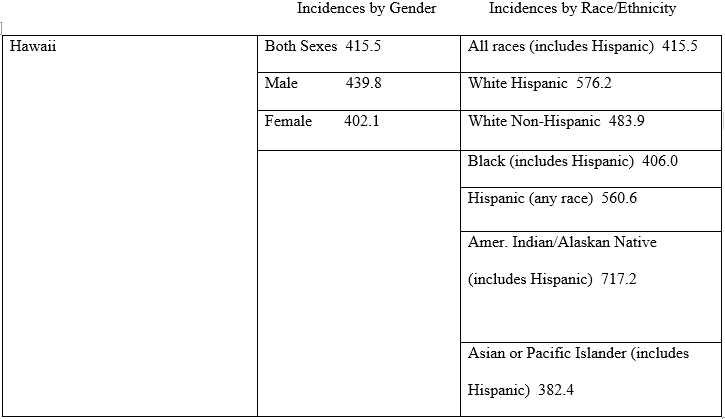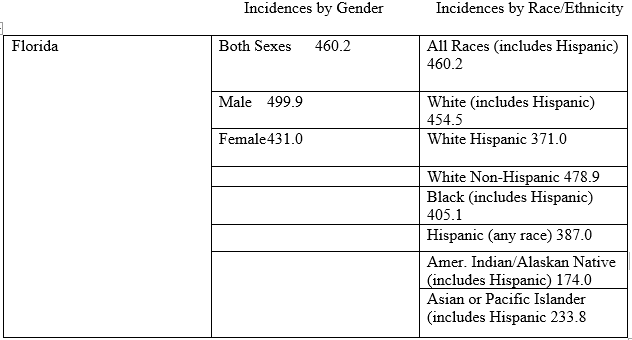Introduction
Cancer is a serious concern worldwide and the second-highest cause of mortality in the U.S. The coronavirus pandemic negatively impacted cancer screening and management in 2020. Due to a delay in the distribution of population-based monitoring data, it will require many years to calculate the outbreak’s present and other indirect implications. Overall, the two states in focus for comparison are Hawaii and Florida (see tables 1 and 2). Hawaii is a geographically and demographically diversified state. Aside from lacking an ethnic majority, Hawaii has the greatest percentage of individuals identifying as people of mixed race in the United States. The most common cause of death in the state is lung cancer. In contrast, Florida has the second-highest cancer incidence in the United States. For the past eight years, lung and bronchus cancer has been Florida’s second-highest cause of mortality, behind cardiovascular disease. The data presented in the tables below show cancer incidences in Hawaii and Florida from 2014 to 2018 concerning gender and race/ethnicity.
Comparison of data from a database at the National Cancer Institute State Cancer for two states
Table 1: Cancer Incidences in Hawaii from 2014 to 2018 (Gender and Race/Ethnicity)

Table 2: Cancer Incidences in Florida from 2014 to 2018 (Gender and Race/Ethnicity)

According to the above data, Florida has higher cancer incidences in all gender categories compared to Hawaii. Females have the lowest cancer incidence rates in both states (National Cancer Institute, 2022). In terms of both sexes, Florida has higher cancer rates than Hawaii. A possible explanation is that individuals of both sexes in Florida are not seeking early cancer diagnostics and treatment. However, this is not the case when comparing incidences regarding ethnicity. The data shows that Hawaii leads Florida in all race/ethnic-related categories except all races (comprising Hispanic) (National Cancer Institute, 2022). Notably, in the second last ethnic category, the incidence rate for cancer in Hawaii is four times that of Florida (National Cancer Institute, 2022). This suggests that Hawaii’s native communities are not taking timely cancer diagnostics. On the contrary, it could mean that cancer incidence rates among the same groups in Florida are underreported.
Conclusion
Overall, data from both states affirm that cancer is a serious public health problem in the U.S. Cancer is the most expensive disease in the U.S., and cancer patients frequently incur large out-of-pocket medical expenses. The disease is, therefore, mostly emotionally and physically taxing for individuals affected and their caregivers. Thus, states play a crucial role in ensuring that more people with cancer undergo screening and those with the disease receive treatment and adequate care.
References
Agency for Healthcare Research and Quality. (2014). Preventing Pressure Ulcers in Hospitals. Ahrq.gov. Web.
McGonigle, D. & Mastrian, K. (2017). Nursing informatics and the foundation of knowledge (4th Ed.). Jones & Bartlett.
National Cancer Institute. (2022). State Cancer Profiles > Quick Profiles. Cancer.gov. Web.